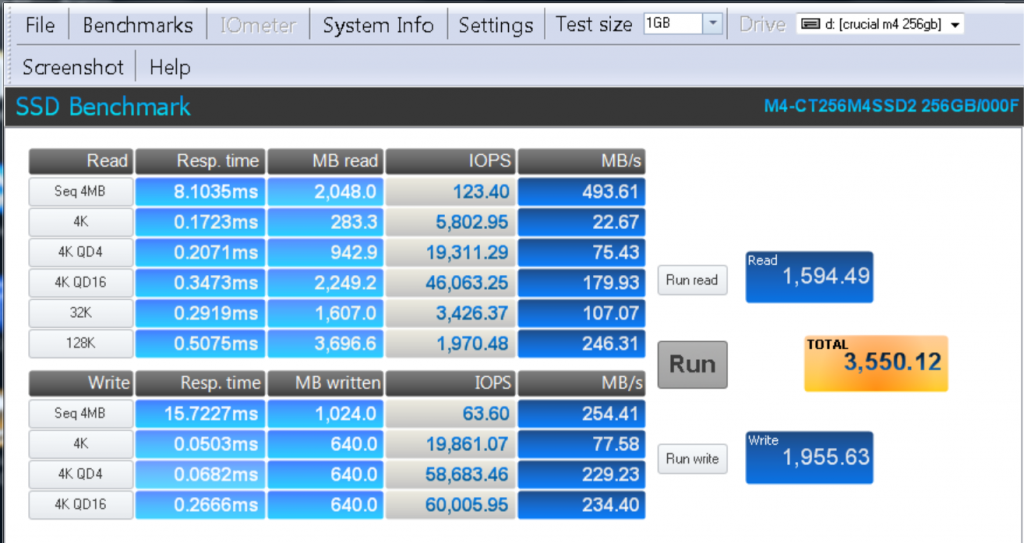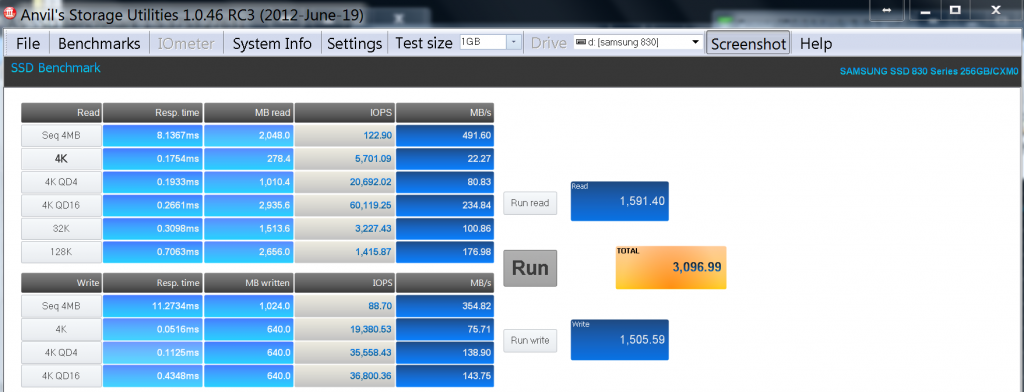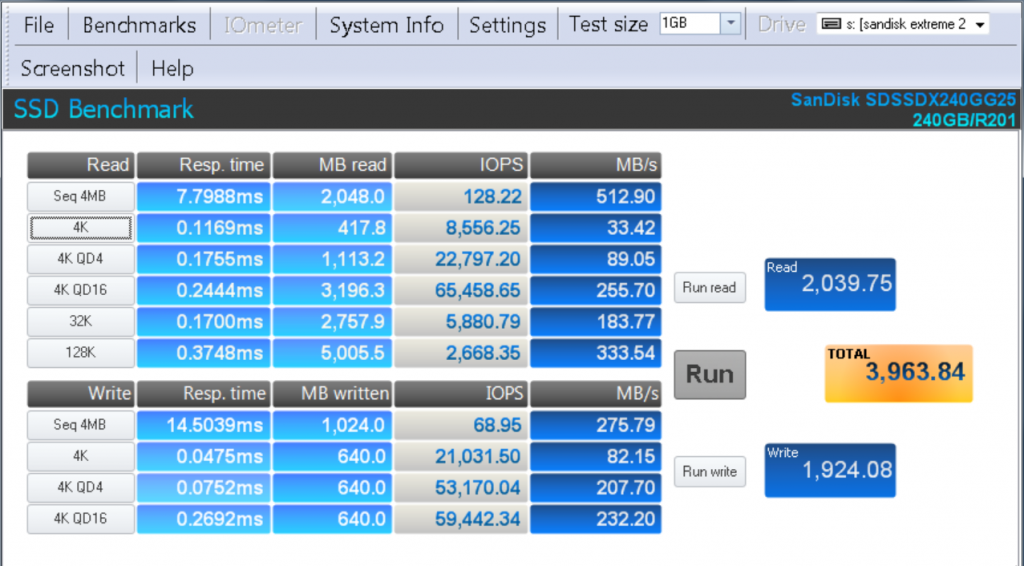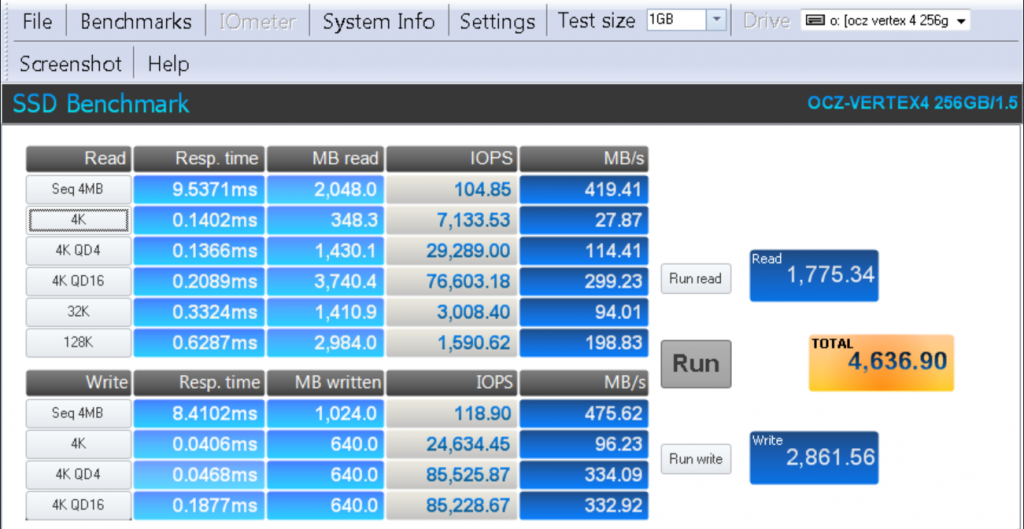Lately I have done a few SSD benchmark sessions on some of today’s popular SATA III solid state drives. One thing that I did not have is results of Anvil’s Storage Utilities bechmarks for all of those reviews. I actually think Anvil’s utilities represent one of the better, if not the most complete picture of solid state disk performane these days so I decided to put raw output from four recently reviewed drives on one page. As such below are the Anvil results for the Crucial M4 256GB, SanDisk Extreme 240GB, Samsung 830 SSD 256GB and OCZ Vertex 4 256GB. I do think that the sweet spot in terms of price and performance is at 240-256GB at the moment which is why I have been focusing on these drives. Also, for those wondering, all of these drives are retail samples purchased from Amazon recently so they are not “special” review samples.
Test Configuration
I am using a Sandy Bridge test bed here as the Cougar Point SATA 6.0gbps controller is perhaps the best 6.0gbps SATA controller on the market at the moment.
- CPU: Intel Core i5-2500K
- Motherboard: ASUS P8H67-M EVO
- Memory: 8GB 1600MHz CL9 DDR3 (4x2GB)
- OS Drive: OCZ Agility 2 120GB
- Additional Drives: (as noted)
- Additional NICs: Intel Gigabit CT PCIe x1 network adapter
- Enclosure: Supermicro SC731i-300B
- Power Supply: Supermicro 300w (included in the SC731i-300B)
As with any modern SSD, set the controller to AHCI mode or RAID mode for best performance. Also, installing the Intel RST 10.xx series drivers over the default Windows 7 drivers showed a nice performance gain.
I do think that I will begin using the Intel Z77 chipset in the near future but wanted to provide a baseline using the H67 for the solid state drive reviews.
Anvil’s Storage Utilities Comparison
Whereas easy to run storage benchmarks had been very simplistic in nature up to recently, Anvil’s Storage Utilities does an excellent job of being easy to run while at the same time testing several different types of disk access patterns.
Crucial M4 256GB
The Crucial M4 256GB is an aging drive, but is still an excellent performer and is frequently found on sale.

As we saw in the Crucial M4 256GB review, the Marvell controller does a solid job, but sequential write speeds are a bit below best-in-class at this point.
Samsung SSD 830 256GB
Samsung drives are known for solid all-around performance and possibly even better firmware. Generally Samsung and Intel are known in the industry to have extremely high quality products and for that reason we often see Samsung win may OEM designs from Apple, HP, Dell and others. There is something to be said for stability. Apologies for the picture in advance, I screwed up the settings but you can click on the images for larger versions.

Performance wise, the Samsung 830 SSD turns in the lowest Total score of all drives here which is similar to what we saw in the Samsung 830 SSD 256GB review. What we do see is that at higher queue depths, the 4K file size speeds are a bit below what we are seeing with the other drives.
SanDisk Extreme 240GB
SanDisk uses the fruit of their joint venture with Toshiba, or Toggle NAND, alongside a LSI SandForce SF-2281 controller to build a low cost, high performance 240GB drive.

The LSI SandForce controller shows strong speeds. At this point, the SandForce firmware tends to be very mature and I have had great luck personally with the newer drives except where TRIM was required. The trim fix is coming very soon apparently. If one has compressible loads, the SandForce drives are very competitive.
OCZ Vertex 4 256GB
The OCZ Vertex 4 256GB drive is one that we have seen increasing performance with every subsequent firmware release. The thought on how this drive works is that it writes one bit per cell instead of two to the free area of the drive. The firmware attempts to keep the free area as large as possible so one can write to about half of the free area and get really high performance. I have actually bounced back and forth on this, but realistically, there are very few times when you write more than half of free area. The real use case here is when you have a server being accessed 24×7 so the garbage collection algorithms cannot fire. Otherwise, the performance looks much like we saw in the OCZ Vertex 4 256GB v1.5 firmware review.

For most desktop scenarios, the garbage collection does get to run before one writes to half of the drive’s free space. We can make synthetic scenarios but I really think there are two to look at, 24×7 server and desktop. Desktop, I think the Vertex 4 may be the best solution available right now as the numbers above simply blow away other solutions. Server I would still look at Intel, Samsung or SandForce drives.
Conclusion
Overall, I think that the performance of the empty drive OCZ Vertex 4 256GB is great with the newest firmware. As we have found out through testing, the drive does loose performance under heavy writes of more than 50% free capacity. I am going to go out on a limb here and offer a different perspective than I read about on many sites. First, if you are purchasing a solid state drive or multiple drives for a specific application, optimize your purchase around that. For example, if all you need to do is store text files, SandForce drives are amazing as the write amplification stays low and speed high due to compression algorithms. Beyond that, I think the Veretex 4’s performance is simply great but I am not sure that I would spend more than $5-15 more on a 256GB drive for the performance benefit. Realistically, if any of the drives above showed a significant price/ capacity advantage over other drives, that would guide my purchasing decision. Just to give readers an idea, I actually use Intel X25-M drives as boot drives on many machines to this day. Fresh install, the newest SATA III drives boot less than 1s faster than that older drive. The general thought here is, optimize for capacity and reliability, then for benchmark speed unless you have a specific application where there is a big benefit for one SSD over another.




Nice work! Thanks for finally posting all of these. Good to see raw detail.
Am I the only one that tries to stay away from OCZ SSDs regardless or price? Seems like every month or so a firmware release screws up something new over at the OCZ camp.
It is too bad you cropped the bottom of the ASU screenshot out. There is a lot of good-to-know information down there. Like whether it is using compressible or incompressible data, what driver is being used (MSAHCI, Intel RST incl. version), what motherboard, etc.
Also, I think the total ASU score is not useful, since it is unspecified how the various measurements are weighted to get the overall score. For example, in your screenshots the Vertex 4 has the best overall ASU score by far, but the Vertex 4 has poor sequential read performance, and also poor 32K random read performance. For many usage scenarios, those two parameters will make the Vertex 4 a poor performer compared to other SSDs.
Paul:
No, you are not the only one. OCZ has a long history of deceptive business practices, high RMA rates, and poor customer satisfaction. I will not touch an OCZ SSD for any price.
Paul:
You are not the only one. OCZ has a long history of deceptive business practices, high product return rates, and a large percentage of dissatisfied customers. I would not touch an OCZ SSD at any price.
What version of Anvil were you running ?
RC2 has 100% non compressible data, much more real life like performance
The oldest versions had a 100% compressible data, which made Sandforce controllers look good as they can cheat with zero fills.
RC3. That is one reason I stayed away from the earlier versions. I did not want another ATTO-like set of results.
The earlier versions of ASU could still use 100% incompressible data, you just had to select it in the configuration. But Anvil wisely changed the default to 100% incompressible on recent ASU versions.
By the way, the comments are flakey here. Sorry about the double post earlier, but my first post showed up immediately, so when my second post did not show up, I tried again. Neither the 2nd or 3rd post showed up until a day later.
jwill42: Pages get cached both on server and on the browser. The server side gets refreshed on posts but sometimes the browser side does not. Still have not had time to troubleshoot that one.